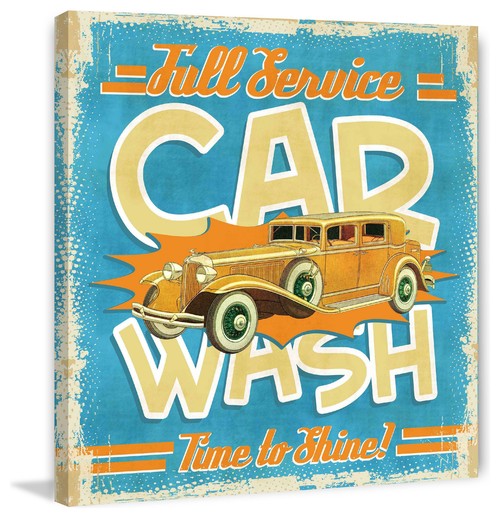Not many of us are aware that washing our cars in our driveways is one of the most “environmentally un-friendly” chores we can do around the house. In fact, by washing all that winter grime off our vehicles we might actually be causing harm to our local waterways. Water entering storm drains, unlike water that enters sanitary sewers, does not undergo treatment before it is discharged into our waterways. When cars are washed on streets and driveways that dirty water eventually winds up in rivers, streams, creeks, and lakes.

Shop prints and posters on Houzz
Dirty water containing soap, detergents, residue from exhaust fumes, gasoline, heavy metals from rust, and motor oils can wash off cars and flow directly to storm drains and into the nearest creek or stream where it can harm water quality and wildlife.
Commercial Car-Washes & Homeowner Car-Wash
Federal laws in both the U.S. and Canada require commercial car-wash facilities to drain their waste water into sewer systems, so it gets treated before it is discharged back into the great outdoors. Not to mention that commercial car washes use computer controlled systems and high-pressure nozzles and pumps that minimize water usage. Many also recycle and re-use the rinse water.
Washing your car is only a problem if you don’t know where or how to do it correctly. The average homeowner uses 116 gallons of water to wash a car! Most commercial car washes use 60 percent less water for the entire process than a homeowner uses just to rinse the car.
What Can You Do?
Obvious the best way to minimize the effect washing your car has on the environment is to use a commercial car wash. However, if you choose to wash your car at home or on the street, these are some things that you can do. You can minimize the water quality impact and also you can wash your car using less water.
1. Avoid washing your car on the driveway with a hose as it wastes water and allows dirt, grease and detergents to run down drains. Place it on a grassy area instead, to minimize run-off. However, use a sponge and bucket or watering can. It takes a little more time than using a hose but saves water. Washing your car with a hose typically uses four or five times as much water as the sponge-and- bucket option.
2. Park also your car under the shade. This prevents excess water evaporating off and the exterior from becoming hot. Ideally the spot should be close to a water source so you don’t have to carry water very far.
3. Try to use vegetable oil based soaps to wash your car, but if you do use car shampoos, always wash your car on the lawn. Even when using green-friendly cleaners, it is better to avoid the driveway and instead wash your car on your lawn or over dirt so that the toxic waste water can be absorbed and neutralized in soil instead of flowing directly into storm drains or open water bodies.
Car shampoos contain phosphates similar to those found in fertilizers. Imagine fertilizers in our rivers and lakes. The phosphates from shampoos can cause excess algae to grow. Excessive algae smell bad, look bad, and harm water quality. As algae decay, the process uses up oxygen in the water that fish need.
4. Waterless car wash products are perfect for small jobs. One way to avoid such problems altogether is to wash your car using any number of waterless formulas available, which are especially handy for spot cleaning and are applied via spray bottle and then wiped off with a cloth.
5. Consider reusing your laundry rinse water to wash the car. Using grey water, as its known, is a good way of getting twice as much use out of a precious resource.
Several Smart Ideas for Your Home – Inspiring Tips (howtobuildahouseblog.com)


